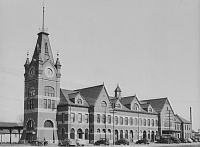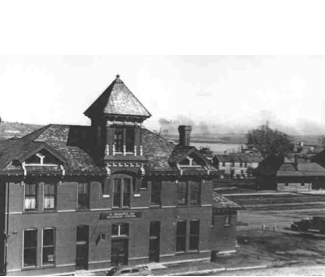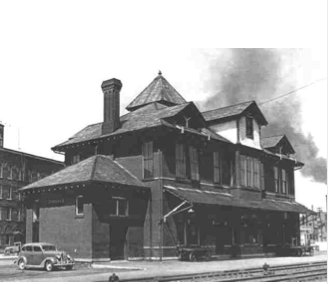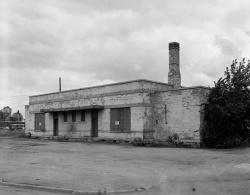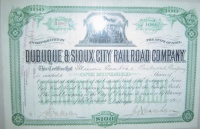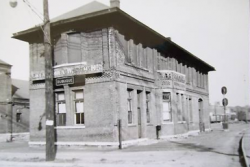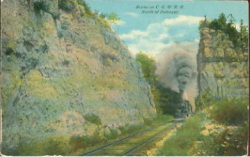Encyclopedia Dubuque
"Encyclopedia Dubuque is the online authority for all things Dubuque, written by the people who know the city best.”
Marshall Cohen—researcher and producer, CNN
Affiliated with the Local History Network of the State Historical Society of Iowa, and the Iowa Museum Association.
RAILROADS: Difference between revisions
No edit summary |
No edit summary |
||
| Line 51: | Line 51: | ||
[[Image:CNWRR.png|left|thumb|250px|Postcard showing the railroad passing through a cut north of Dubuque.]] | [[Image:CNWRR.png|left|thumb|250px|Postcard showing the railroad passing through a cut north of Dubuque.]] | ||
By the late 1800s, railroads had replaced steamboats as the primary means of transportation. This encouraged the development of cities away from rivers and near to interior sites of agriculture. Railroads like the Illinois Central advertised throughout eastern states and Europe to tell people land was available. Railroads even arranged passage for potential customers to view the land. Plans called for towns to develop in intervals from five to fifteen miles along the track. This was considered a reasonable distance to travel for farmers to bring products into town for shipment. (11) Towns established before railroads or those which did not comply with railroad requests could be by-passed. Some towns relocated or like Hanover, Illinois formed the Hanover Railway Company to construct a 2.5 mile track to the Chicago and Great Western Railroad lines. | |||
In August 1894 an ordnance was proposed forcing railroads to pay for street improvements where their tracks were located. This ordinance was in compliance with a law passed by the previous session of the Iowa legislature. ( | In 1899 the ''Railroad Gazette'' estimated that 4,557 miles of new railroad lines had laid in the United States. It went on to claim that Iowa had more new trackage than any other state having added 552 miles in that year. Minnesota was second with 374. (12) | ||
In August 1894 an ordnance was proposed forcing railroads to pay for street improvements where their tracks were located. This ordinance was in compliance with a law passed by the previous session of the Iowa legislature. (13) In 1904 the railroads assured the chief of police that they would respect the ordinance of not operating in the city limits in excess of six miles per hour. (14) | |||
Research is still being done on the [[ST. PAUL AND DUBUQUE RAILROAD COMPANY]] which it is believed became part of the [[DUBUQUE AND NORTHWESTERN RAILROAD]]. | Research is still being done on the [[ST. PAUL AND DUBUQUE RAILROAD COMPANY]] which it is believed became part of the [[DUBUQUE AND NORTHWESTERN RAILROAD]]. | ||
| Line 81: | Line 83: | ||
10. Illinois Central Historical Society | 10. Illinois Central Historical Society | ||
11. "New Railway Lines," ''The Herald'', December 31, 1899, p. 4. Online: http://p8080-10.30.40.140.ezproxy.dubuque.lib.ia.us/ResCarta-Web/jsp/RcWebImageViewer.jsp?doc_id=76d75574-3467-4ecf-9df4-c2b7da149f1e/ResCarta/00000002/00001465 | 11. Sisco, Becky and John Everly,"Towns Formed, Thrived Near Railroads," ''Telegraph Herald'', September 28, 2001, p. 1 | ||
12. "New Railway Lines," ''The Herald'', December 31, 1899, p. 4. Online: http://p8080-10.30.40.140.ezproxy.dubuque.lib.ia.us/ResCarta-Web/jsp/RcWebImageViewer.jsp?doc_id=76d75574-3467-4ecf-9df4-c2b7da149f1e/ResCarta/00000002/00001465 | |||
13. "A New Ordinance," ''Dubuque Daily Herald'', August 10, 1894, p. 4 | |||
14. "Want Compromise," ''Dubuque Telegraph-Herald'', January 28, 1904, p. 3 | |||
[[Category: Industry]] | [[Category: Industry]] | ||
Revision as of 16:51, 29 October 2017
RAILROADS. The passage on September 20, 1850, of the Illinois Central Land Grant by the United States Congress provided the first grant of public lands to assist in the construction of railroads. (1) This law led to the passage of the Iowa Land Grant Act and eventually the construction of the ILLINOIS CENTRAL RAILROAD between Dubuque and Sioux City.
The passage of the Illinois Central Land Grant Act, a special concern of Senator George Wallace JONES included a provision that the railroad in Illinois should have a branch line to Dubuque. This fact, acclaimed in Iowa, led to hordes of settlers moving into eastern Iowa.
Shortly after the construction of the Illinois Central began in Illinois, Lucius Hart LANGWORTHY and Jesse P. FARLEY began plans for a transcontinental railroad westward from Dubuque to the Pacific Coast. This had been the dream of John PLUMB, Jr. as early as 1838.
A meeting in Dubuque on April 28, 1853, was held to organize the company. The name DUBUQUE AND PACIFIC RAILROAD was chosen with the company's capital stock fixed at $10 million. The company was formally incorporated on May 19, 1853. Besides Langworthy and Farley, those involved in the company included Asa HORR and Platt SMITH.
Although those who incorporated the railroad were men of great wealth, the immense amount of capital needed to fund the ambitious project required two years of fund raising. Construction bonds were sold as low as fifty cents on the dollar in some places. By 1855 enough capital had been raised to begin work.
The ceremonial first spade of dirt was turned on October 1, 1855. Anticipating a business boom, speculators doubled land prices in Dubuque almost overnight. The construction of the railroad fueled further immigration into Iowa. A report of the number of FERRYBOATS crossing the MISSISSIPPI RIVER to Dubuque from April 12 to July 5, 1856 recorded 812 families totaling 4,504 people. Dubuque hotels accommodated 865,045 travelers in 1855.
On September 10, 1856 a pot-bellied, wood-burning locomotive from New Jersey was ferried across the Mississippi. The "Jesse P. Farley," named for the president of the railroad's president arrived soon after and made its first trip to Dyersville on May 11, 1857. The track did not have rock ballast, so cordwood was used to firm the rail bed. Despite this, the engine jumped the rails three times on its first trip. (2) The time schedule was as follows: (3)
Dubuque to Julien..............60 minutes
Julien to Caledonia (Peosta)...26 minutes
Caledonia to Epworth...........40 minutes
Epworth to Farley..............28 minutes
Farley to Dyersville...........35 minutes
The first train entered Earlville, then boasting two houses, on September 22. The panic of 1857 came as a severe blow to the company. Nearly all of the land the company received--1,251,040 acres--was immediately sold or given to creditors at an estimated price of two dollars per acre. (4) By 1857 the company was almost entirely under the control of Abram S. Hewitt of New York due to its inability to pay interest on construction bonds. Trying to keep confidence in the project alive led the Dubuque and Pacific Railroad to publish Northern Iowa: Containing Hints and Information of Value to Emigrants, a wonderful example of boosterism describing Iowa's opportunities.
Nearly two years of inactivity came to an end when the thirty-two miles between Earlville and Independence were completed on December 12, 1859. Train service between Dubuque and Jesup, seventy-eight miles apart, was completed on March 2, 1860.
Shortly after the completion of the line to Jesup, the Dubuque and Pacific Company was forced into receivership by Morris K. Jesup, the largest creditor. Taking over the business, Jesup saw the company reorganized on August 13, 1860, as the DUBUQUE AND SIOUX CITY RAILROAD. Company reports stated that the railroad owned thirty-five flat cars, six passenger cars, sixty-five box cars, and four locomotives. The railroad reached Waterloo on March 11, 1861, where the arrival was acclaimed as an end to the long overland trips to Dubuque to sell goods and obtain supplies. Twenty days after its arrival in Waterloo, the railroad reached Cedar Falls.
As the sectional hostilities increased before the CIVIL WAR, railroads played an important role in strengthening the North. Southern states relied heavily on steamboats. Railroads in the North, however, pushed west. By providing markets for crops and livestock, railroads succeeded in converting the West into an economic satellite of the North. (5)
The start of the Civil War suspended further construction. For the next four years, Cedar Falls was the western terminus of the line. East of Dubuque, the Illinois Central and the Chicago and Galena railroads linked Dubuque with eastern cities.
The war had a marked effect on railroad transportation. Stalled shipments out of Dubuque by way of the Mississippi River led to stores of grain in Dubuque increasing faster than they could be shipped. Wartime use of the rails was further harmed after January 1865 when only government cars were given the right-of-way. Dubuque businessmen, feeling harassed, pledged $100,000 to the first railroad completing its track from Lake Michigan to Dubuque. The Julien Theater was the scene of a Shippers and Merchants Convention on March 1-2, 1865 which considered building another railroad eastward from Dubuque.
Railroad construction resumed with peace. By April 16, 1866, the DUBUQUE AND PACIFIC RAILROAD had reached Iowa Falls, 143 miles west of Dubuque. Business boomed freighting livestock to market and offering passenger service to immigrants headed west. (6) The Dubuque and Sioux City Railroad existed only on paper after 1867 when the Illinois Central leased the road. (7) In 1870 the Illinois Central joined the track to Sioux City. (8) The lease on the road ended in 1870 and the Illinois Central forced to Dubuque and Sioux City to sell its stock at $80 per share. (9)
The DUNLEITH AND DUBUQUE BRIDGE was completed in December 1869. (10) Considered an engineering triumph of the day, it was built by the Keystone Bridge Company headed by Andrew CARNEGIE. Regular train service from Chicago through Dubuque to Sioux City began on October 10, 1870.
Like the hub of a wheel, Dubuque became the center of intense railroad building. Railroad construction out of the city southward was the goal of the DUBUQUE, BELLEVUE, AND MISSISSIPPI RAILWAY. With forty thousand acres of land and $300,000, the company planned to lay track through Jackson and Clinton counties.
To the north, the Dubuque, the Saint Peter and Saint Paul Railroad joined with the Turkey River Valley Railroad Company. A projected route extended through Clayton, Fayette, and Howard counties into southern Minnesota. Although this promised valuable trade with Dubuque, the line was never constructed.
With the goal of reaching markets to the southwest, the DUBUQUE WESTERN RAILROAD planned to reach Anamosa. There it would link itself to the Iowa Central Air Line Railroad to connect Dubuque with trade in Benton, Boone, Jones, Linn, Tama and Marshall counties. Organized in September 1855, the company built an independent track from its depot yards through the northern city limits of Dubuque to the track belonging to the Dubuque and Pacific at Center Grove. The Dubuque Western, financed by a $200,000 private subscription, a loan of $200,000 voted by Dubuque residents, and a land grant, leased Dubuque and Pacific track to Farley Junction before building south. The Dubuque Western reached Anamosa by 1860. After consolidation and being renamed the Dubuque Southwestern Railroad, it pushed on toward Cedar Rapids.
To the northeast, the Dubuque and Waukegan and Dubuque, Arena, and Watertown promised Dubuque access to valuable forests of Wisconsin around Milwaukee and Green Bay.
The year 1867 was crucial in the history of Dubuque's railroads. Sioux City, hoping to challenge Council Bluffs and a "gateway to the West," pressured the Dubuque line to hurry construction of its track between Iowa Falls and Sioux City. This would enable Sioux City to link itself with the Union Pacific at Fremont, Nebraska, and thus beat Council Bluffs which hoped to be the link for the Chicago and Northwestern Railway and Union Pacific. At this point, the Illinois Central entered Iowa. The Dubuque and Sioux City line, lying between Dubuque and Iowa Falls, was leased to the Illinois Central on September 13, 1867, and a million dollar bridge, DUNLEITH AND DUBUQUE BRIDGE, was contracted.
Financing railroad construction was accomplished in part by the private issuance of notes from the railroad company. Examples of this in Dubuque include hand-dated notes issued by the Dubuque and Pacific Railroad Company; the DUBUQUE, MARION, AND WESTERN RAILROAD COMPANY; the Dubuque and Sioux City Railroad; and the Dubuque Western Railroad Company.
By the late 1800s, railroads had replaced steamboats as the primary means of transportation. This encouraged the development of cities away from rivers and near to interior sites of agriculture. Railroads like the Illinois Central advertised throughout eastern states and Europe to tell people land was available. Railroads even arranged passage for potential customers to view the land. Plans called for towns to develop in intervals from five to fifteen miles along the track. This was considered a reasonable distance to travel for farmers to bring products into town for shipment. (11) Towns established before railroads or those which did not comply with railroad requests could be by-passed. Some towns relocated or like Hanover, Illinois formed the Hanover Railway Company to construct a 2.5 mile track to the Chicago and Great Western Railroad lines.
In 1899 the Railroad Gazette estimated that 4,557 miles of new railroad lines had laid in the United States. It went on to claim that Iowa had more new trackage than any other state having added 552 miles in that year. Minnesota was second with 374. (12)
In August 1894 an ordnance was proposed forcing railroads to pay for street improvements where their tracks were located. This ordinance was in compliance with a law passed by the previous session of the Iowa legislature. (13) In 1904 the railroads assured the chief of police that they would respect the ordinance of not operating in the city limits in excess of six miles per hour. (14)
Research is still being done on the ST. PAUL AND DUBUQUE RAILROAD COMPANY which it is believed became part of the DUBUQUE AND NORTHWESTERN RAILROAD.
---
Source:
1. "Illinois Central Railroad" (Corporate History), Encyclopedia of Chicago, Online: http://www.encyclopedia.chicagohistory.org/pages/2716.html
2. "Dubuque's $10 Million Railroad Was Vital Link With Early West," Telegraph Herald, September 2, 1962, p. 20
3. Ibid.
4. Ibid.
5. Ibid.
6. Ibid.
7. Illinois Central Historical Society. Online: http://www.icrrhistorical.org/milestones.html
8. "Dubuque's $10 Million..."
9. Ibid.
10. Illinois Central Historical Society
11. Sisco, Becky and John Everly,"Towns Formed, Thrived Near Railroads," Telegraph Herald, September 28, 2001, p. 1
12. "New Railway Lines," The Herald, December 31, 1899, p. 4. Online: http://p8080-10.30.40.140.ezproxy.dubuque.lib.ia.us/ResCarta-Web/jsp/RcWebImageViewer.jsp?doc_id=76d75574-3467-4ecf-9df4-c2b7da149f1e/ResCarta/00000002/00001465
13. "A New Ordinance," Dubuque Daily Herald, August 10, 1894, p. 4
14. "Want Compromise," Dubuque Telegraph-Herald, January 28, 1904, p. 3


